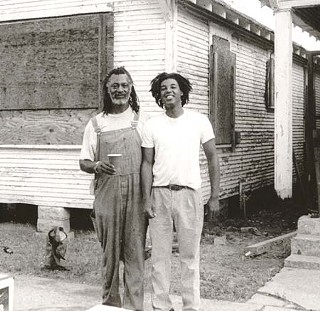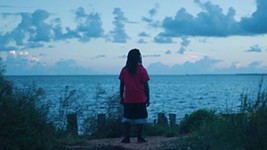Property Value
Andrew Garrison on how Houston artists and inner-city neighbors rebuilt a community
By Anne S. Lewis, Fri., March 9, 2007
Houston's Third Ward, or at least the upper part of it, was one of those left-for-dead inner-city neighborhoods with a rich African-American legacy, one that began with the emancipation of the slaves in 1865 and reached its apogee, ironically, during the segregation era, when a majority of the city's blacks, spanning all socioeconomic levels, lived and thrived in this city within a city. We know what happened post-integration. What's fresh about the Third Ward's story, the subject of filmmaker Andrew Garrison's documentary, is that its present and future are, well, looking up, thanks to a group of artists. Yes, you read that correctly: artists. As best put by Rick Lowe, an artist and one of the seven founders of the 1993 community-renewal project called Project Row Houses, the underlying philosophy was that a community – like the world itself – is a big shapeable sculpture which, with proper shaping, can be changed for the better. What Lowe and his fellow artists – each with ties to the local Texas Southern University – did was take over a block of abandoned, condemned Thirties-era row houses, or "shotgun houses," and then ask the neighbors what they wanted done for their neighborhood, how to bring attention to the issues confounding it since integration robbed it of its essential vitality and cohesiveness.
Austin Chronicle: And they said?
Andrew Garrison: Pick up all the glass, and get the junkies out of here. So they put together this drive-by exhibit, which involved boarding up these abandoned houses and putting up paintings on them. Then they used a [National Endowment for the Arts] grant to buy 22 condemned houses on two blocks and, with help from corporations and local neighborhood volunteers, rehabbed these row houses. Eight of these houses were turned into exhibition houses for visiting artists. Every six months, eight artists – some with international reputations, others whose reputations were launched after their work at PRH, and other local artists – spend weeks preparing a house. Then they have an opening; the exhibit stays up for six months, and then a new group comes in and starts over. Another eight houses are allocated for single mothers going to college, with various programs to support them and their families, as well.
They've been so successful with all of this, and the location is so close to downtown and to the museum district that it's become valuable real estate. They knew that they'd be facing gentrification but thought it was at least 15 years away. Instead, it started happening very quickly. They actually tried slowing down some of their activities so they wouldn't draw so much attention to themselves but then decided that the thing to do was morph into a housing organization. So, they split in two; they still do all the art things, but now they've created this Community Development Corporation that does low-income housing, building housing for sale and rent in a way that replicates the old row, or shotgun house, look. The front porches are gathered together in a way that fosters community. Even the two-story houses that they've subsequently built face each other and have front porches and also have common courtyards. This has all been helped along by Rice University architecture students and faculty. The plan now is to concentrate their work in 35 square blocks with the idea of building low-income housing and helping to create ownership in that area, as well as enable those who are already there to benefit from the inevitable development that's already coming. And maybe also to be able to influence what other developers coming into the area will do. Gentrification is just beginning.
For me, at least, the film is about how people can shape the community in which they live, how they can have an effect on what they want, and, then, how do you put a value on that? How do you value the idea that my neighbor across the street knew me when I was a little kid, knew my family, and can tell me about them? One of the common ills in America today is that we feel this loss of connection. Here, they're trying to rebuild that sense of connection but are up against market forces that are very hard to fight.
AC: What were some of your own hurdles in making this film?
AG: One of our major challenges was being a mixed race team coming into this neighborhood. I'd heard about the Third Ward from Nancy Bless, from Texas Folklife Resources, who'd been an arts writer. ... There's a self-consciousness about coming into this neighborhood: People were looking at us and we at them. It was an awareness, not a significant barrier. When you're making a documentary, you're always intruding into people's lives, but in this context, when white people had come to the neighborhood before, they were either the police or news people. We found that it was important that we just kept showing up, that we were a presence; it was important that people be able to recognize us. So, that was one benefit of the shoot taking so long – over six years. Lots of news stories had been written about the neighborhood, and several filmmakers had started films but never finished them. I think they were kind of surprised when we actually came in to show them our rough cut. They were happy to see that the film was actually getting made. ![]()
THIRD WARD TX
World Premiere
Friday, March 9, 9:30pm, DobieThursday, March 15, noon, Dobie













